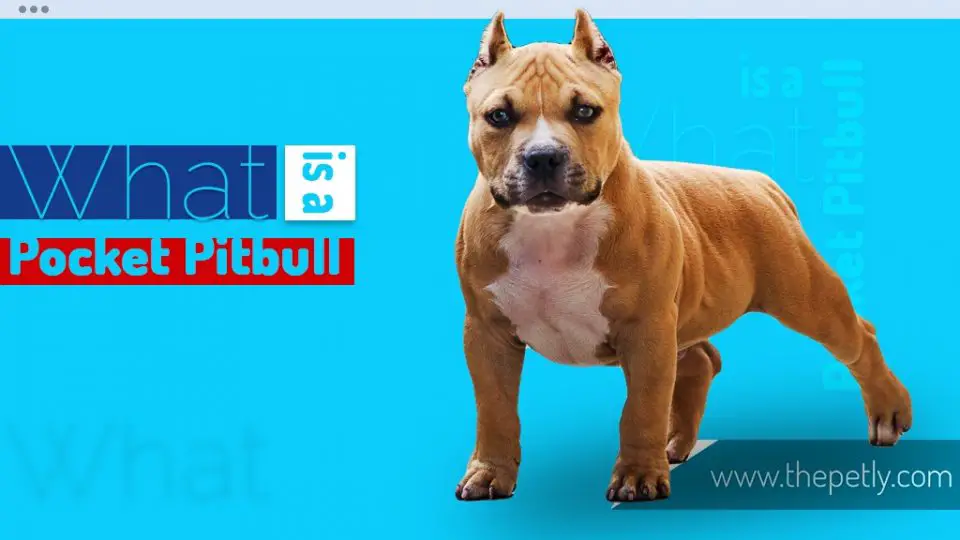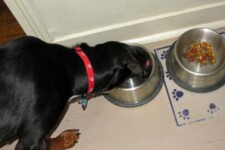The Complete Pocket Pitbull Guide (Know Your Facts)
Pocket dogs are becoming more popular all the time, and no doubt you have seen photos of celebs with their little pocket dynamos.
Generally pocket dogs are tiny, and you can hold them in one hand, however in the instance of Pocket Pitbull’s this isn’t exactly the case.
Unlike teacup-size breeds like Teacup Yorkie or Teacup Pugs, a Pocket Pitbull can’t fit inside a pocket or sit on your hand – they are a bit bigger than that!
Why The Name Pocket Pitbull?
The name refers to their size compared to a fully grown Pitbull, and they are considerably shorter with a much smaller body than normal full-size Pitbull’s. Even though they are small versions of their breed, they maintain the same physical stature of their parent breeds.
In this article we’re going to look at some background info, general prices, features, health issues, care requirements, and more.

Other Names Given to the Pocket Pitbull
There are other acronyms given to Pocket Pitbull’s that you may find confusing if substituted for another.
In case you see them used in somewhere else, they refer to the same dog or slightly similar as we will see in the coming section.
These names include:
- Pocket Pit.
- Pocket Bully.
- Patterdale.
- Pitbull Patterdale mix.
- American Pitbull Terrier.
- Mini Pitbull.
- Miniature Pitbull.
Pocket Pitbull Background Information
Sometimes you may come across the buzzword ‘purebreed‘.
Although the term may be relative depending on who is using it, it refers to a dog that originates from a single pedigree of a pure bloodline. Meaning, no different breeds involved during breeding.
For the Pocket Pitbull, the breed is as the result of breeding a Patterdale Terrier with an American Pitbull Terrier.
These two are from a different pedigree to each other – therefore, the resulting breed is not a pure breed, rather a high breed.
Although the result is this amazing designer dog, no one can say with clarity when the original breeding occurred.
There is neither official documentation of the breeding and breeders nor any kennels that have ever claimed the work.
However, when you trace the origin of the breed, it’s quite certainly British.
Take for the case of the Patterdale Terrier, though it can be found in the United States, it’s root points back to Britain.
The same origin applies to the American Pitbull Terrier and the rest of the Pitbull families.
Read our guide on how to identify different Pitbull breeds
How Much Is A Pocket Pitbull
When it comes to the value of a Pocket Pitbull, even though they are not a pure breed, they are even more valuable than Pitbull’s themselves.
It is because they are considered a pure hybrid, a result of breeding two originals breeds.
Due to their scarcity they attract a lot of attention, spark plenty of curiosity, and have a lofty status among high profile breeders.
Because of these reasons, breeders often charge hefty prices.
For instance, a Pocket Pitbull puppy will easily fetch a value of over $2,500, and people are usually happy to pay way more than this just to get one of these rare dogs.
Most breeders have advance orders before puppies are even born, and there aren’t many pups for sale that are already in stock.
Normally breeders will require $1,000 deposit to secure your place in line to purchase puppies yet to be born, and once they are ready for sale the prices are generally in the $3,000 – $7,500 range.
If you are looking at the latest designer Pocket Pitbull with aesthetic features not commonly seen, we are often seeing them selling anywhere from $10,000 to $25,000.
They can charge these prices since the features in their pups will come from a very unique mating adult that produces offspring with physical attributes not found at any other breeder – making them truly designer dogs.
Things To Know About Pocket Pitbull’s
Now that you have the basic background info, I will cover everything(mostly) that you should know about the Pocket Pitbull.
The aim is to arm you with the insights that will enable you not only take good care of your Pocket Pitbull but also help you decide whether it’s the right dog for you, or is worth the investment.
How Big Is A Pocket Pitbull?
Head features
The Pocket Pitbull head has similar proportions to the parent breed, except they have a little bit shorter muzzle but strong jaws.
They have the same smiley face as a full-grown American Pitbull Terrier.
The Body Shape
When it comes to the shape of the Pocket Pitbull, it really depends on the parent’s breed characteristics, and they will vary according to the specific breeding.
Generally you will see short legs, a heavily built form, and a wide chest that screams strength, and agility.
How Much Does A Pocket Pitbull Weigh?
Pocket Pitbull’s can vary in weight due to breeding, male, female, or strongest and weakest of a litter.
Generally you will find them in the 12 – 22lb range.
How Tall Are They?
Their standing height is around 14 inches to 17 inches for a male, and 13 inches to 16 inches for a female.
Anything above these bounds is not classified a Pocket Pitbull.
The Skin And Coat
Pocket Pitbull’s have a single-layered skin covered by a beautiful short and aligned shiny coat that it inherits from its parents.
The coat comes with a wide variety of shades such as gray, white, black panther tint, brown, and cream.
Common Care, Grooming and Coat Requirements
Like its full sized ancestors, Pocket Pitbull’s do not have a problem with frequent shedding.
In fact they don’t need professional grooming, just regular brushing, and to keep them in optimal health, they need normal pet care like washing, nail clipping, and ear cleaning.
In general, you don’t have to worry much about their cleanliness because they are a low maintenance dog.
Are Pocket Pitbull’s Dangerous? Temperament and Personality
Even though the historical background (original intentions) of the Pitbulls cannot be disputed, a Pocket Pitbull is different from its ancestors.
First, it ‘s a cross-breed between two breeds that have a clean background when it comes to obedience and loyalty.
Second, they respond well when given proper training by the owner, especially when done from a young age.
Here is the thing, for the parent dogs each has its own unique traits – take for example the Patterdale Terrier, which was bred for hunting and digging out small tunneling animals. As a result, it’s a hard worker and self-driven. Thus, it can be stubborn and fierce.
On the other hand, the American Pitbull Terrier is more of a guard dog. The big gun that is meant for scaring and charging prey. However, when both parents are given great obedience training, they are docile, harmless, and they make great family dogs.
It’s obvious the Pocket Pitbull will inherit the parents’ temperaments and behaviors.
However, also under close supervision and firm obedient training these pint-sized dogs make a great family dog with a fair amount of temper only when provoked due to its protective nature.
Also bound within its character, is a charismatic behavior and attention seeking – they love attention from humans.
A Pocket Pitbull is not usually dangerous – but it depends on the type of training it is given.
If you want a loyal, friendly, and playful Pocket Pitbull give it the best obedience training while still young, and follow-up the training with frequent socialization classes.
How To Train A Pocket Pitbull
Like it’s master who is an extremely intelligent breed, the Pocket Pitbull is also a smart dog.
It is bold, independent, and it can be boisterous – a no-nonsense bad boy!
Therefore, when it comes to its training you’ll have to challenge it into bending to your will.
You will need to introduce a Pocket Pitbull to obedience and socialization classes early in their life if you want to end up with a well-mannered and a friendly companion.
Exercise Frequency And Living Conditions
There is this misconception I would wish to challenge.
Because the Pocket Pitbull is a relative-small-sized dog, it doesn’t need a larger space or frequent hard training like normal Pitbull breeds, however that is a wrong belief.
If you haven’t noticed yet, the parent breeds are quite active dogs. So, someone with a small house or apartment, and of a quiet reserved nature could find them annoying.
These dogs are agile, playful, and independent, and they demand intensive exercises.
An hours walk or jog per day with your little Pitbull is a must, and for good manners and hedging it against boredom and aggressiveness, frequent socialization is a must.
If you come from states like Minnesota or Alaska where the weather is the opposite of warm, you need their bed near a fireplace for better warmth. But for warmer places make sure to put its bed near the window for rejuvenating morning sunshine.
Pocket Pitbull’s coat is short, they have a single-layer skin, and they are pint-sized, so their body needs a considerate warmth to keep it active.
Cold environments are not suitable for them unless they are given sources of heat to balance their body temperature, warm bedding, and coats to wear outside when cold.
Feeding and Nutritional Requirements
Since a Pocket Pitbull’s nutritional requirements are not that different to their full-size forbears.
Quality commercial food products with meat as key ingratiate is the ideal food for it, but avoid foods with a lot of veggies.
Just like standard Pitbull’s, they are also energetic, so they need to be fed with an active formula diet and plenty of fresh water.
Check out our posts about the best food for pitbulls to gain muscle, and affordable food choices for pitbull’s
Through the stages of growth, it’s better that you feed them with formulated food that suits a specific stage, like best dog food for puppies, adults, and seniors.
Also observe health-related diet requirements, like diabetes and weight management.
When it comes to feeding frequency, it’s best feed them at least three to two times a day.
Ensure not to overfeed them, and don’t feed them within 30 minutes of training sessions. Failure to observe either case can lead to a fatal health outcome.
Health Issues Relating To Pocket Pitbull’s
The Pocket Pitbull is fairly a new breed and so far no medical research is available to cite health problems relating to them.
Furthermore, they are a hybrid, which gives them a small edge over disease tolerance compared to pure-breeds.
Like their ancestors, they have a high tolerance for pain, so it’s important to check their physical condition regularly, especially after heavy exercise, since they can easily mask injury symptoms.
That said, and the fact that the Pocket Pitbull is a strong and a healthy dog, the parents’ breeds have known health issues.
As a result, there is a high chance that it can also get the same genetic diseases as cited in the following discussion.
Demodicosis
Demodicosis is also known as Demodex mange, and Demodectic mange.
It is the advanced effect caused by mites that cause the dog to lose hair.
These mites can be transferred from the mother to puppies especially during feeding and normal parent-puppy interactions.
Although, there is no advanced effect associated with this problem except for autoimmune reactions, a dog with depleted hair (called mange) is not a great picture of a healthy living pet.
To help fight this menace, here are a few suggestions.
- Start by isolating the dog from the rest.
- Follow by using anti-parasitic medications.
- Include treatments that ease itching, inflammation, and secondary skin infections
Hip Dysplasia
Hip Dysplasia is a common problem found in the Pitbull family, and it is no different with the Pocket Pitbull.
The big challenge in advance stages is causing arthritis and crippling hip joints.
To make sure you fight it, ensure you have your Pitbull tested by the Orthopedic Foundation for Animals (OFA).
By doing so, you will prevent further breeding of the dog with similar health challenges.
We highly recommend ensuring the breeder provides proof of the parent being free of this defect, as this gives a greater chance that your expensive little pal will be free from this genetic problem.
Visual Problems
Visual impairment can become frustrating to a vigorous Pocket Pitbull.
It is important you prioritize their checkup with agencies like the Canine Eye Registration Foundation (CERF).
If you are ever in doubt of who to consult, check with your vet for further assistance.
Allergies
When it comes to allergies, it’s important to consider the root of the problem.
To Pitbull’s in general, the major problem stems from wrong diet selection, so to avoid problems disqualify any feeds that have traces of soy, yeast, wheat, and corn.
There is also a tendency of manufacturers adding colors, artificial flavors, and by-products to make feeds look real. Steer away from such dog foods.
Such malpractices should be discouraged because they are dangerous and source of allergies.
Common Diseases Of Pocket Pitbull’s
- Cataracts.
- Hip Dysplasia.
- Cerebellar Abiotrophy.
- Luxating Patella.
- Brachycephalic Syndrome.
- Demodicosis/Demodex.
- Hypothyroidism.
- Heat Intolerance.
- Mange/Demodectic Mange.
- Elbow Dysplasia.
- Cleft Lip/Palette.
- Congenital Heart Failure.
- Gassiness.
- Atophy.
- Ichthyosis.
- Zinc Responsive Dermatosis.
- Progressive Retinal Atrophy.
Final Thought
Finally you may ask, “is the Pocket Pitbull a good family dog?”
Of cause yes, all it needs is a great leader, space, and an active person.
What about its conduct with small and growing kids?
All you need is great socialization and obedient training. But always ensure that your Pitbull is immunized and is under supervision especially if left with other small animals.



